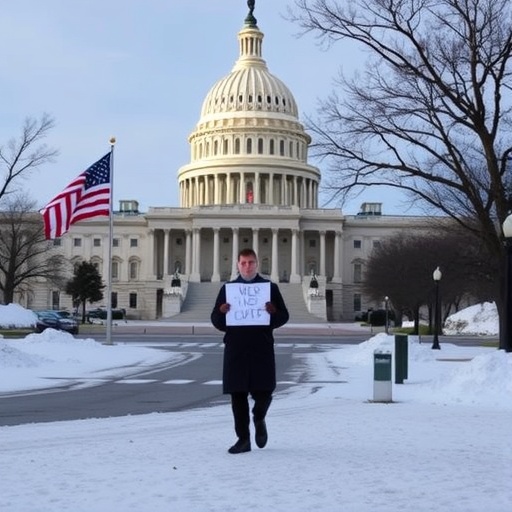US Government shutdown Hits Second-Longest Mark as Senate Deadlocks on Health Care Subsidies Extension
In a tense standoff that’s rippling through the nation’s capital and beyond, the U.S. Government shutdown has stretched into its 28th day, cementing its place as the second-longest in American history. At the heart of the impasse is a fierce debate in the Senate over extending pandemic-era health care subsidies, with Republicans pushing for fiscal restraint and Democrats warning of dire consequences for millions of Americans. Treasury Secretary Scott Bessent’s recent plea for bipartisan compromise has done little to bridge the divide, leaving federal workers furloughed and essential services strained.
- Senate Republicans Insist on Subsidy Overhaul Amid Fiscal Concerns
- Moderate Democrats Rally to Safeguard Health Care Access for Vulnerable Families
- Treasury Secretary Bessent’s Urgent Call for Bipartisan Bridge-Building
- Economic Ripples Widen: From Furloughed Workers to Strained Hospitals
- Path Forward: Potential Breakthroughs and Lingering Risks in Shutdown Saga
Senate Republicans Insist on Subsidy Overhaul Amid Fiscal Concerns
The Government shutdown, now surpassing the 2018-2019 impasse but falling short of the record 35-day closure in 1995-1996, has ground legislative progress to a halt. Senate Republicans, led by figures like Minority Leader Mitch McConnell, have made it clear that any extension of the enhanced health care subsidies—originally introduced under the Affordable Care Act (ACA) during the COVID-19 crisis—must come with strings attached. These subsidies, which cap premium costs at 8.5% of household income for eligible individuals, have been credited with enrolling over 21 million people in marketplace plans last year alone, according to the Centers for Medicare & Medicaid Services (CMS).
“We can’t keep borrowing from future generations to fund open-ended entitlements,” McConnell declared in a floor speech last week, emphasizing the program’s projected $300 billion cost over the next decade if extended without reforms. Republican senators from budget-conscious states like Wyoming and Idaho have been particularly vocal, arguing that the subsidies distort market incentives and inflate federal spending at a time when the national debt exceeds $35 trillion. Data from the Congressional Budget Office (CBO) supports their caution, estimating that without adjustments, the subsidies could add $64 billion annually to the deficit starting in 2025.
Behind the rhetoric, party strategists reveal a deeper calculus. With midterm elections looming, Republicans see the shutdown as leverage to force Democrats into concessions on broader spending priorities, including border security and energy independence. Yet, this hardline stance risks alienating moderate voters in swing states, where health care affordability remains a top concern. A recent Kaiser Family Foundation poll showed 62% of Americans oppose cuts to ACA subsidies, underscoring the political tightrope both parties are walking.
Moderate Democrats Rally to Safeguard Health Care Access for Vulnerable Families
On the other side of the aisle, moderate Democrats in the Senate are mounting a vigorous defense of the health care subsidies, framing the extension as a non-negotiable lifeline for working families battered by inflation and economic uncertainty. Senators like Joe Manchin of West Virginia and Kyrsten Sinema of Arizona—known for their centrist leanings—have joined forces with progressive leaders to block any Republican-led bill that doesn’t preserve the full scope of the pandemic-era enhancements.
“These subsidies aren’t just numbers on a page; they’re the difference between a family affording insulin or skipping meals,” Manchin said in an interview with CNN, highlighting how the program has reduced uninsured rates to historic lows of 8% nationwide. The subsidies, set to expire at the end of the year, have particularly benefited rural and low-income communities, with enrollment surging 40% in red states during the pandemic. Without extension, experts warn, premiums could skyrocket by an average of 75%, pricing out up to 4 million people from coverage, per a Urban Institute analysis.
Democrats’ strategy hinges on public pressure, with advocacy groups like AARP and the American Hospital Association flooding Capitol Hill with letters and testimonies. In a bipartisan nod, even some red-state Democrats have shared poignant stories from constituents: a single mother in Ohio who credits the subsidies for keeping her diabetes treatment affordable, or a veteran in Pennsylvania spared from bankruptcy after losing employer-sponsored insurance. This emotional appeal has resonated, as evidenced by a 55% approval rating for the subsidies in a Pew Research Center survey conducted amid the shutdown.
The deadlock has also exposed fractures within the Democratic caucus. While progressives demand even broader expansions, moderates are open to minor tweaks, such as income verification reforms, to appease GOP concerns. However, any compromise feels distant as procedural votes in the Senate repeatedly fail, with filibuster threats from both sides prolonging the stalemate.
Treasury Secretary Bessent’s Urgent Call for Bipartisan Bridge-Building
Stepping into the fray, Treasury Secretary Scott Bessent has emerged as a key voice urging de-escalation, warning that the prolonged government shutdown could exacerbate economic vulnerabilities at a precarious moment. In a letter to Senate leadership released yesterday, Bessent emphasized the subsidies’ role in stabilizing the health care market, which employs over 18 million Americans and contributes 18% to GDP.
“The American people deserve leaders who can rise above partisanship,” Bessent wrote, echoing his remarks at a virtual press briefing where he outlined the Treasury’s projections: a potential 0.5% drag on GDP growth if the shutdown extends into December, coupled with delayed tax refunds and Social Security payments affecting 70 million recipients. Bessent, a former hedge fund manager appointed for his Wall Street credentials, has been leveraging his financial expertise to highlight the subsidies’ efficiency—delivering aid at a cost of just $2,500 per enrollee annually, far below traditional Medicaid expansions.
His intervention isn’t without controversy. Critics on the left accuse Bessent of softening Democratic demands, while Republicans dismiss his overtures as election-year posturing. Nonetheless, Bessent’s push aligns with broader administration efforts, including closed-door negotiations facilitated by White House Chief of Staff Jeff Zients. Insiders report that Bessent has personally met with a dozen senators, floating ideas like a two-year extension tied to deficit-reduction measures, such as pharmaceutical price negotiations already in the Inflation Reduction Act.
Bessent’s background adds intrigue; his tenure has focused on fiscal responsibility, yet he’s advocated for targeted investments in health care as a bulwark against post-pandemic recovery setbacks. If his compromise blueprint gains traction, it could unlock not just the subsidies but also stalled infrastructure funding and disaster relief packages caught in the shutdown crossfire.
Economic Ripples Widen: From Furloughed Workers to Strained Hospitals
As the Senate remains mired in debate over health care subsidies, the government shutdown’s tangible impacts are mounting, painting a picture of widespread disruption. Over 800,000 federal employees are furloughed or working without pay, with the Economic Policy Institute estimating weekly losses of $1.5 billion in wages alone. Small businesses near federal installations, from D.C. delis to national park vendors, report 30-50% revenue drops, per National Federation of Independent Business surveys.
In the health care sector, the stakes are even higher. Hospitals reliant on Medicare and Medicaid reimbursements—totaling $1.2 trillion annually—are facing cash flow crunches, delaying expansions and staff hiring. The American Medical Association has warned that subsidy uncertainty could lead to 10% fewer preventive care visits, potentially spiking emergency room costs by $20 billion over the next year. Stories abound of individuals like Maria Gonzalez, a freelance graphic designer from Florida, who fears her $450 monthly premium will double without the credits, forcing her to forgo coverage amid rising living costs.
Broader economic indicators reflect the strain: Consumer confidence dipped to 98.7 in the latest Conference Board index, the lowest since early 2023, partly attributed to shutdown fears. Stock markets have been volatile, with health insurer shares like UnitedHealth dropping 4% on subsidy-related jitters. Internationally, the impasse has drawn scrutiny, with IMF officials noting it could undermine U.S. credibility in global fiscal talks.
Yet, amid the gloom, glimmers of resilience emerge. Community health centers have ramped up free clinics, and states like California and New York are exploring temporary subsidy matches using their own funds. These stopgaps, however, underscore the urgency for federal resolution, as patchwork solutions can’t fully mitigate the chaos.
Path Forward: Potential Breakthroughs and Lingering Risks in Shutdown Saga
Looking ahead, the Senate’s deadlock on health care subsidies shows few signs of immediate resolution, but several catalysts could shift the dynamics. Speaker of the House Mike Johnson has signaled willingness to advance a clean extension bill if the Senate acts first, potentially pressuring holdouts. Bipartisan working groups, quietly convening since last week, are exploring hybrid proposals: a phased extension through 2026 with built-in cost controls, such as eligibility caps for high earners.
Public opinion may prove decisive. Protests outside the Capitol, organized by groups like Families USA, have drawn thousands, chanting against the shutdown’s human cost. Polling from Gallup indicates 68% of voters blame congressional gridlock equally on both parties, a sentiment that could punish incumbents in upcoming elections.
If no deal materializes by mid-November, the Treasury could invoke emergency measures to delay subsidy lapses, buying time but risking legal challenges. Bessent has hinted at such contingencies, while Democrats float attaching the extension to must-pass legislation like the farm bill. Ultimately, the saga’s outcome will test the limits of bipartisanship in a polarized era, with implications for health care policy far beyond this shutdown. As negotiations intensify, all eyes remain on the Senate, where compromise could avert catastrophe—or prolong the pain for millions relying on these vital supports.








